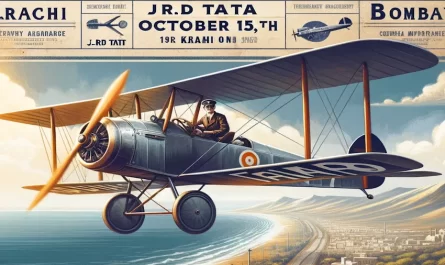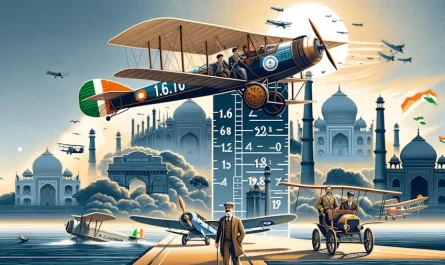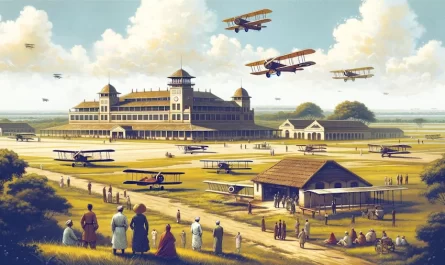Sarla Thakral became the first Indian woman pilot in 1936 at age 21, breaking societal norms. She earned her flying license flying a Gypsy Moth. Despite her career being cut short by WWII, Sarla’s legacy inspires women in aviation and beyond.
Contents
Ah, let’s dive into an exhilarating journey back in time to uncover the story of a remarkable trailblazer who soared beyond the confines of societal norms to etch her name in the annals of Indian aviation history. This story is not just about breaking barriers; it’s a testament to sheer determination, unwavering courage, and the indomitable spirit of a woman who dared to dream with her eyes wide open, navigating the skies. Today, we’re celebrating the incredible journey of Sarla Thakral, the first woman Indian pilot who took the realm of the skies by storm in 1936.
Sarla Thakral stepped into a predominantly male domain at a time when the very thought of a woman pilot was beyond the realm of imagination for many. Born in 1914, she was not only ahead of her time in aspirations but also in her achievements. At the tender age of 21, married and a mother, Sarla did not let societal expectations define her limits. Her resolve led her to Lahore Flying Club, where she embarked on her journey to becoming the first Indian woman to earn a pilot’s license.
Imagine the scene as she climbed into the cockpit of a Gypsy Moth, a light aircraft of that era, wearing a traditional saree — a symbol of her cultural identity blending seamlessly with her groundbreaking ambition. Her first solo flight marked not just a personal achievement but a monumental moment for women across India and beyond. Sarla Thakral’s venture into the skies was a bold statement that women could achieve anything they set their minds to, breaking stereotypes and laying the groundwork for future generations of women aviators.
Her story doesn’t end with just her piloting achievements. Although the outbreak of World War II halted her flying career, Sarla’s spirit remained unbound. She later pursued a successful career in art and design, proving that her pioneering spirit knew no bounds. Sarla Thakral’s life is a beacon of inspiration, symbolizing the power of dreams and the importance of perseverance. She demonstrated that with passion and resilience, even the sky is not the limit.
In commemorating Sarla Thakral, we not only celebrate her historic flight but also her enduring legacy that continues to inspire countless women to pursue their dreams in aviation and beyond. Her journey reminds us of the importance of breaking barriers and forging new paths, regardless of the challenges that lie ahead. Sarla Thakral will always be remembered as a pioneering figure who charted a new course, encouraging us to aim high and fly beyond the horizons of possibility.
So, as we revel in the tales of those who’ve soared before us, let’s remember Sarla Thakral not just as the first woman Indian pilot, but as a symbol of enduring courage and limitless potential. Her story is a clarion call to all dreamers and doers to never let anything clip their wings. Fly high, dream big, and remember, the sky’s the limit!
Who is the first Indian female commercial pilot?
Prem Mathur is recognized as the first Indian female commercial pilot, flying for Deccan Airways in the late 1940s and early 1950s. Her groundbreaking career paved the way for women in Indian aviation.
Who is the Indian girl pilot in USA?
There have been several Indian female pilots making their mark in the USA. One notable example is Shivangi Singh, who flies for major airlines. However, numerous Indian women have achieved significant milestones in the US aviation sector.
Who is the best female pilot in India?
“Best” can be subjective, but among the notable is Harpreet A De Singh, who was the first woman to be appointed as the CEO of Alliance Air, a subsidiary of Air India. She has had a trailblazing career in aviation administration.
Who is the first Indian woman to fly a fighter jet?
Avani Chaturvedi made history in 2018 as the first Indian woman to fly a fighter jet solo, piloting a MiG-21 Bison. She is one of the first three women to be inducted into the Indian Air Force as a fighter pilot.
Gypsy Moth
The de Havilland DH.60 Moth represents a cornerstone in aviation history, an iconic 1920s British aircraft that left an indelible mark on both touring and training in the early days of flight. Developed by the de Havilland Aircraft Company, this two-seater aircraft was a marvel of its time, blending elegance with functionality, a testament to the pioneering spirit of aviation.
Initially taking to the skies in 1925, the DH.60 Moth was powered by a reliable Cirrus engine, setting it apart for its performance and reliability. Its design was revolutionary, featuring a distinctive wood and fabric construction that combined light weight with structural integrity, making it an ideal choice for a variety of flying conditions.
The Moth’s adaptability led to the development of several variants, including the Gypsy Moth and the Tiger Moth, each iteration building on the success of its predecessors, enhancing capabilities, and broadening the scope of its use. It became a fundamental tool in pilot training, especially during World War II, where it played a crucial role in preparing pilots for combat. The Moth series not only democratized flying, making it accessible to more people but also laid the groundwork for the development of future training aircraft. Its legacy continues to inspire a sense of adventure and the pursuit of innovation in the aviation industry.
Aviation in India : History1st airport in India
First Indian International Flight
Who is the first woman Indian pilot?
What airports in India are currently handling Airbus A380s
India International Airports
How many airports are there in India?
Airport Codes of Lakshadweep Islands
New Indian Airports and terminals
How Early to Arrive at Indian Airports?



